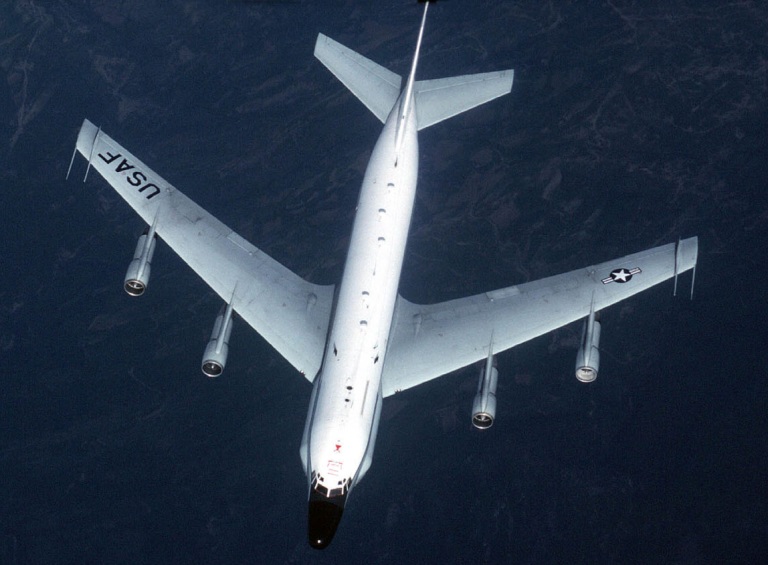TAIPEI, TAIWAN - A reported spike in U.S. military flights over the seas near China reflects Washington’s drive to understand and deter Chinese expansion in contested waters, analysts say.
U.S. military surveillance planes flew off China’s coast 60 times in September, more than in July or August, according to Chinese state-backed research organization South China Sea Strategic Situation Probing Initiative’s website.
When contacted by VOA, U.S. Army Maj. Randy Ready, a spokesperson for the U.S. Indo-Pacific Command, would say only that flight frequency near China has been consistent over time.
Most sorties flew over the South China Sea, the organization’s website says. Beijing contests sovereignty over that resource-rich, 3.5 million-square-kilometer sea with five other Asian governments, and U.S. Secretary of State Michael Pompeo said in July that Washington would help other states resist Chinese expansion.
U.S. air activity would back up Pompeo’s directive, said Sean King, vice president of the Park Strategies political consultancy in New York.
Pompeo had called China's actions at sea illegal, and any increase in flights this year “can be considered commensurate with the U.S. State Department's July policy statement that specific PRC South China Sea claims are unlawful,” King said.
American pilots probably feel an increased U.S. government concern about Chinese activity in the air and underwater, said Alexander Huang, strategic studies professor at Tamkang University in Taiwan.
Pilots can track any Chinese submarines and “familiarize” themselves with the sea, Huang said. A particular point of interest, he said, would be the Luzon Strait, between Taiwan and the Philippines’ Luzon Island, because U.S. allies aren’t as strong at that South China Sea entry point as they are in the East China Sea, he said.
'Exploitation, corruption and coercion'
China alarmed other countries as it expanded in the sea from about 2010 through 2017 by landfilling tiny islets for military, civilian and resource exploitation purposes. It has more firepower than the other maritime claimants, including Brunei, Malaysia, the Philippines, Taiwan and Vietnam.
Pompeo accused China's governing Communist Party earlier this month of “exploitation, corruption and coercion” in its treatment of other countries. Beijing points to historic usage records as support for its claim to about 90% of the South China Sea.
Of the U.S. flights that the Chinese research organization says passed offshore in September, it reports that two-thirds went to the South China Sea. Some planes were disguised as Malaysian or Philippine aircraft, the organization’s October 12 report online says. The report says the U.S. planes were sent to "spy" on China.
Ready did not comment on the number of September flights or their motive beyond saying that flight frequency had been consistent.
China is paying attention to U.S. missions because it wants the United States to think it couldn’t win an air war with China, said Stephen Nagy, senior associate professor of politics and international studies at International Christian University in Tokyo. The United States has an advantage in combat and deployment experience, plus backup, if needed, from allies including Japan, South Korea and Australia, he said.
Washington has to show its air power, Nagy said, because “I think China has tried to create the narrative that it can make any conflict with China extremely expensive for the United States.”
American planes fly anywhere that it’s legal and continue their flights in Asia, Ready said.
“While the scope of our operations varies based on the current operating environment, the U.S. has a persistent military presence and routinely operates throughout the Indo-Pacific, including the waters and airspace surrounding the East China Sea and the South China Sea,” he said.
He called the air movement “a continued demonstration of our commitment to the region and our willingness to defend the freedoms enshrined in international law.”
The command’s Twitter feed said in August that an MV-22B Tiltrotor aircraft was preparing to land on the USS New Orleans amphibious transport vessel. The mission promoted “interoperability with allies and partners” to “defend peace and stability” in a tract of ocean that includes the South China Sea.
The U.S Navy’s P-8A Poseidon patrol planes, one type mentioned by the Chinese research organization, plays a “key role” in Asia, particularly on joint missions with other countries, the U.S. Naval Institute website said in 2018.
Naval EP-3E Airborne Reconnaissance Integrated Electronic System II surveillance planes, another kind of aircraft cited by the Chinese organization, are the same type as one that China forced to land in 2001 as it flew just 130 kilometers offshore.
Officials in Washington may see the September flights as routine, said Oh Ei Sun, senior fellow with the Singapore Institute of International Affairs.
“What China would consider unusual might not be felt the same from the U.S. side,” he said.
Southeast Asian countries that dispute China’s maritime claims “welcome” any increase in U.S. air movement, Oh added.
Beijing will take no “actual action” against the U.S. surveillance planes aside from making statements, King forecast.

China Reports Spike in US Surveillance Flights
A reported spike in U.S. military flights over the seas near China reflects Washington’s drive to understand and deter Chinese expansion in contested waters, analysts say. U.S. military surveillance planes flew off China’s coast 60 times in September, more than in July or August, according to...




